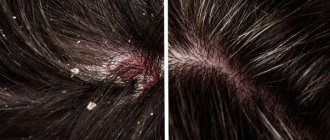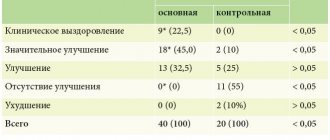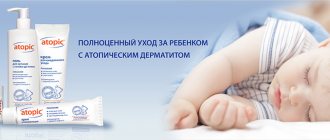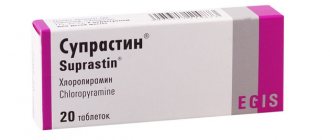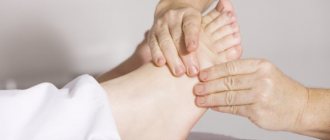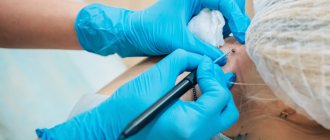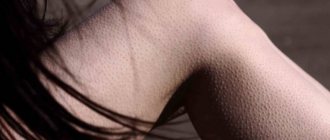Dandruff
(Pitiriasis Simplex Capitis)
Dandruff is characterized by the appearance of a large number of loose grayish-white scales on the scalp, mainly in the occipital-parietal region. Most often it is one of the manifestations of seborrhea, but it can also be associated with metabolic disorders in the body and improper hair care. Some scientists consider dandruff as an infectious process associated with the presence of the opportunistic fungus Pitirosporum Ovale on the scalp.
The appearance of dandruff is a consequence of a disruption in the normal cycle of skin cell renewal. Typically, the cell renewal process occurs every 28 days. At the same time, old cells remain on the surface of the skin as dead, keratinized scales and gradually peel off, unnoticed by us. When washing your hair with too hot water, using low-quality or unsuitable shampoos for this skin type, frequent drying and blow-drying, as well as stress and illness, excessive cell renewal occurs and, accordingly, a large amount of dandruff appears.
What is dermatitis
Atopic dermatitis (eczema) is a non-contagious skin disease that occurs as a result of skin hypersensitivity. The main cause is a reaction to allergens, such as animal hair, detergents, and the fabric from which clothes are made. Friction and other mechanical stress on the skin increase the risk of dermatitis. The disease often manifests itself in childhood and affects the skin for a long time.
Dermatitis, like psoriasis, can appear on different parts of the body, but most often it occurs on the hands, which are constantly in contact with chemicals, and also occurs on flexion surfaces: the inner sides of the elbows, the backs of the knees. Dermatitis spots are red, without a clear outline, do not have dry scales, and can ooze. In advanced cases, bleeding cracks appear. In dry areas, the affected areas need to be moisturized as much as possible, because the skin can be re-infected.
Seborrhea
Seborrhea is a skin disease manifested by a disorder of sebum production, which may be associated with a change in both the secretory function of the sebaceous glands and the chemical composition of sebum due to the accumulation of free fatty acids in it.
In the mechanism of development of this disease (in addition to such factors as genetic, endocrine, gastrointestinal, stress), considerable importance is attached to the disruption of the physiological balance of female and male sex hormones towards the latter, which is especially pronounced in adolescence. However, the quantitative and qualitative characteristics of sebum also depend on the state of the nervous and digestive systems, the nature of nutrition, and concomitant diseases.
With seborrhea, the bactericidal properties of sebaceous secretions are suppressed. It accumulates in the ducts of the sebaceous glands and on the surface of the skin, creating conditions for the development of pyococcal infection, which is manifested by the formation of acne; This is usually caused by improper skin care. The course of seborrhea is aggravated by diseases of the gastrointestinal tract, chronic infections, hypovitaminosis (especially A and C), as well as skin contamination. In the context of this resource, we are primarily interested in seborrheic manifestations on the scalp, and also in the fact that seborrhea is recognized as one of the possible causes of thinning of the scalp.
Oily seborrhea . Most often, seborrhea occurs as an oily type. There is an increase in the secretion of the sebaceous glands. Hair quite quickly, often already on the second or third day after washing, becomes greasy, shiny, takes on an unkempt appearance, and sticks together in greasy strands. Dandruff forms on the scalp from greasy flakes, which easily comes off when scraped.
Dry seborrhea . With this pathology, sebum secretion is reduced, the hair gradually becomes thinner, loses its shine, becomes brittle, breaks off and splits at the ends, and begins to fall out rapidly. Dandruff appears on the scalp in the form of easily crumbling, dry whitish scales. The disease is often accompanied by itching.
How to distinguish
It is worth mentioning that dermatitis and psoriasis are not contagious. And any contact with people suffering from these diseases will not lead to infection.
Similarities between atopic dermatitis and psoriasis:
- diseases may be hereditary;
- have several stages of development and periodic exacerbations;
- the affected areas turn red and itch;
- the skin peels and cracks.
Differences:
- dermatitis does not produce pronounced dry plaques, but blisters with pus may appear;
- dermatitis has acute and chronic forms, while psoriasis has only chronic forms.
Treatment of seborrheic psoriasis
Treatment of the disease should be carried out under the supervision of an experienced dermatologist. The doctor will find out the characteristics of the patient’s body, his psycho-emotional state, ask about recent infectious diseases, the presence of chronic diseases, as well as a genetic predisposition to psoriasis.
After questioning and examining dead skin cells, the doctor may prescribe a skin biopsy, and then select medications and develop a system of therapeutic measures to combat psoriasis.
First of all, a dermatologist prescribes drug treatment for psoriasis. Typically, treatment includes:
- the use of external creams, ointments, lotions with hormones, salicylic acid, urea;
- moisturizers;
- medicated shampoos
- detoxification therapy
- taking vitamin complexes;
- taking antidepressants and anti-anxiety medications.
Seborrheic psoriasis inevitably provokes difficulty in adapting to life in society. The unpleasant manifestations of the disease are very difficult to hide, which causes unnecessary stress for the patient. Therefore, when treating psoriasis, dermatologists also select sedatives, antidepressants and psychotropic drugs.
Experts' opinion
The action of Rederm is determined by its constituent components. Betamethasone inhibits the release of inflammatory mediators, prevents the marginal accumulation of neutrophils, reduces inflammatory exudate and the production of cytokines, reduces the migration of macrophages, leading to a decrease in the processes of infiltration and granulation. Thanks to the presence of salicylic acid, it softens the skin, eliminates horny layers and promotes deeper penetration of betamethasone.
The ointment is produced in accordance with the requirements of the GMP standard: confirmed by the conclusions of the Ministry of Industry and Trade of the Russian Federation.
ethnoscience
Traditional medicine recipes will be an effective complement to drug and physiotherapeutic treatment of seborrheic psoriasis. It is important to use natural remedies only after consultation with a dermatologist and an allergy test.
Will help overcome the manifestations of seborrheic psoriasis:
- Dry celandine. 20 grams of plant powder should be mixed with 20 grams of animal or poultry fat. The mixture should be simmered in a water bath for an hour, then cooled and used to lubricate plaques.
- Burdock root, marsh calamus, licorice , nettle leaf, string should be taken in equal proportions and prepare an infusion. This infusion should be applied to the affected areas of the skin.
We hope you will quickly achieve stable remission of seborrheic psoriasis, and this unpleasant pathology will not bother you. And during exacerbations of the disease, try using Rederm ointment with a combination of two components: betamethasone and salicylic acid. The product has anti-inflammatory, antipruritic, antiallergic and keratolytic effects and quickly helps to cope with the manifestations of psoriasis.
Physiotherapy
Physiotherapy will be an effective addition to the treatment of seborrheic psoriasis. During exacerbations of the disease, the dermatologist may recommend the following treatment methods to the patient:
- PUVA therapy;
- laser therapy;
- UFO method;
- plasmapheresis;
- hirudotherapy;
- ultraphonophoresis with drugs
- inductothermy on the adrenal glands.
Spa treatment significantly improves skin condition. A variety of radon, sulfite, hydrogen sulfide baths, mud wraps, and bathing in thermal springs can restore healthy and beautiful skin.
PSORIASIS: clinical picture and treatment
Psoriasis is one of the most common skin diseases. Among chronic dermatoses of childhood, it ranks second after atopic dermatitis. Often, psoriasis that begins in childhood does not go away for many years. This disease is characterized by alternating periods of exacerbations and remissions.
The etiology of psoriasis still remains unknown
There are many hypotheses regarding the causes of this disease, but none of them has become generally accepted. Many researchers recognize the genetic determinacy of psoriasis; The antigens of the major histocompatibility complex that are most often found in patients with psoriasis have been identified. Most patients have hereditary psoriasis, which typically begins in childhood or adolescence. In the absence of hereditary burden, the disease usually manifests itself in more mature people.
Recently, much attention has been paid to the study of immune factors in the etiopathogenesis of psoriasis. A special role is given to activated immunocompetent cells, which secrete a whole cascade of differentiation and pro-inflammatory cytokines, which in turn determine the nature of pathological changes in the skin of patients with psoriasis. Among the most common pathological changes are an inflammatory reaction in the dermis, excessive proliferation and impaired differentiation of epithelial cells.
Clinical picture of psoriasis
Common psoriasis is characterized by papular (nodular) rashes ranging in size from 1–2 mm in diameter to large plaques formed by the fusion of small elements.
At the onset of the disease, the rash in most cases is limited in nature and is represented by single plaques in places of favorite localization (usually on the scalp, extensor surface of the elbow, knee joints, lumbar region, sacrum, etc.). Plaques of bright pink or deep red color have clearly defined edges, covered with loose silvery-white scales, which are easily and painlessly scraped off, revealing a triad of phenomena characteristic of psoriasis: “stearic spot”, “terminal film” and “blood dew”.
The disease over a long period, and sometimes throughout the patient’s entire life, can proceed relatively easily, without disrupting the vital functions of the body. Rashes can be localized, for example, only on the scalp in the form of individual plaques or on the extensor surfaces of large joints as so-called “standby plaques” up to 2–3 cm in size, which does not particularly bother the patient. However, in some cases, psoriatic rashes occupy a large area of the skin, including smooth skin and the scalp (in the form of a helmet), and are accompanied by profuse peeling, a feeling of tightness of the skin, itching, which significantly complicates the patient’s life and forces him to often seek help from a doctor. Psoriasis occurs with periods of exacerbation (progression) and remission. Among the causes of exacerbations are infectious diseases suffered by the patient, psycho-emotional stress, hypothermia, excessive insolation, etc. Often the cause of exacerbation remains unclear. Most patients note a worsening of their condition in the cold season and improvement in the summer, although in some patients there is no seasonality in the course of the disease. Psoriasis can affect not only the skin, but also other organs and systems (liver, kidneys, joints, etc.).
During psoriasis, there are 3 stages: progressive, stationary and regressive. This division is of fundamental importance, since special treatment tactics have been developed for each stage.
The progressive stage is characterized by the appearance of small bright pink nodules, prone to peripheral growth and the formation of plaques of various sizes, which can be isolated or spread up to a universal skin lesion. In the progressive stage, a symptom of an isomorphic reaction is noted (Koebner phenomenon); Typical psoriatic papules appear at the site of damage (trauma, scratches, etc.).
In the stationary stage, the appearance of a new rash stops, the elements become paler in color, and the tendency for the peripheral growth of existing plaques disappears.
The regressing stage is characterized by flattening of plaques, a decrease in peeling, infiltration, resorption of elements with the formation of foci of hypo- or hyperpigmentation at the site of previous rashes.
There is still no generally accepted classification of psoriasis.
It is customary to distinguish between plaque psoriasis (ordinary), exudative, arthropathic, pustular, psoriatic erythroderma, psoriasis of the scalp, psoriasis of the folds, psoriasis of the palms and soles. It should be noted that certain clinical variants of this disease of varying severity can be observed in the same patient.
Exudative psoriasis is characterized by a pronounced inflammatory reaction of the skin, the presence of lamellar scale-crusts (resembling a layer cake in appearance), when removed, the weeping surface of the plaques is exposed. Crusts in exudative psoriasis appear due to the impregnation of scales with exudate. This form of psoriasis requires particularly careful therapeutic intervention.
Arthropathic psoriasis is one of the most severe forms of psoriasis, characterized by damage to the skin and joints. With psoriasis, small, distal joints of the hands and feet are most often damaged, and large joints are less often damaged. Arthropathy can manifest itself against the background of skin lesions, as well as precede them. Psoriatic arthritis is manifested by pain, swelling, and more or less pronounced limitation of mobility of the affected joints. Arthropathic psoriasis more often than other clinical variants leads to disability in patients. In patients with severe skin manifestations (psoriatic erythroderma, pustular psoriasis), the risk of arthropathic psoriasis is highest; in some cases, a combination of severe polyarthritis with relatively mild (limited) skin damage is also noted.
Pustular psoriasis occurs either as a generalized process or in a limited manner, affecting the palms and soles or other areas of the skin. The occurrence of this severe form of psoriasis is facilitated by various factors, in particular stressful situations, infections, irrational general and/or local therapy, etc.
Generalized pustular psoriasis occurs against the background of a deterioration in the general condition, accompanied by fever, leukocytosis, and an increase in ESR. Suddenly, small superficial pustules appear against the background of bright erythema, while patients note a burning sensation and pain. Pustules can appear in place of regular plaques and/or form independently. New foci of pustulation appear in paroxysms, accompanied by a new rise in temperature and occupying large areas of the skin. Merged pustules cause detachment of the epidermis, forming so-called “purulent lakes.” Pustular psoriasis can appear as the onset of the disease or, more often, occur against the background of already existing regular plaque psoriasis.
Limited pustular psoriasis is more common than generalized psoriasis. The rash is localized primarily on the palms and/or soles, but can appear on any other area of the skin. The rash consists of pustules on an edematous, erythematous background. When the palms and soles are affected, there is usually also pronounced skin infiltration. Limited pustular psoriasis is characterized by a milder course compared to the generalized form of the disease. The general condition of patients is usually satisfactory. This form of psoriasis is characterized by a persistent course, frequent relapses, and refractory to treatment methods.
Psoriatic erythroderma is the most severe form of psoriasis, developing with the progression of the psoriatic process and the fusion of plaques, up to universal damage to the entire skin. Erythroderma is characterized by severe hyperemia, swelling, skin infiltration and profuse peeling. Subjectively, a burning sensation, pain, skin tightness, and itching are noted. The disease can begin with erythroderma, but more often occurs with an already existing psoriatic process with varying durations. With erythroderma, there is always a deterioration in the general condition of the patient (fever, enlarged peripheral lymph nodes, heart failure, impaired liver function, kidney function, changes in blood tests, etc.).
Psoriasis of the folds alone is a fairly rare and difficult to diagnose disease. It develops more often in children, the elderly, and overweight individuals and is often accompanied by diabetes mellitus. Plaques are located in the area of large folds (armpits, under the mammary glands, in the perineum, etc.), the navel, and between the fingers. The lesions have sharp boundaries, a deep red color and are characterized by slight peeling and infiltration. Skin folds can also be affected in other clinical forms of psoriasis.
Psoriasis of the palms and soles can exist in isolation or simultaneously with the involvement of other areas of the skin in the pathological process. This type of psoriasis is characterized by the formation of hyperkeratotic lesions with fairly clear boundaries, covered with dense scales, with pronounced infiltration and painful cracks.
Treatment of psoriasis is aimed at suppressing the inflammatory response of the skin and the proliferation of epithelial cells. Treatment is prescribed taking into account the clinical form, stage, extent of the process, the presence of concomitant diseases, the age and gender of the patient, as well as the patient’s medical history and complaints.
For mild, limited manifestations of psoriasis, in some cases, external therapy in the form of salicylic ointment, naphthalan preparations, tar, and topical corticosteroids is sufficient. Severe forms of the disease require complex treatment using detoxification, desensitizing, anti-inflammatory drugs of different groups, physiotherapeutic methods of therapy, external medications, etc.
Treatment is carried out taking into account the stage of the psoriatic process. Therapy of the progressive stage requires special attention and caution. During this period, gemodez is prescribed intravenously, 400 ml 2-3 times a week, 30% sodium thiosulfate solution iv, 10% calcium gluconate solution 10 ml, and various enterosorbents. With concomitant hypertension, it is advisable to administer a 25% solution of magnesium sulfate intramuscularly. Emollient creams or 1–2% salicylic ointment are used externally. At the progressive stage of the disease, the use of drugs containing tar, irritants and highly concentrated agents is contraindicated for external therapy. It is advisable to use physiotherapeutic procedures after acute inflammatory phenomena have subsided.
At the stationary and regressing stages, ointments with naphthalan, tar, salicylic acid can be prescribed, and preformed treatment methods can be used more widely.
Recently, PUVA therapy or photochemotherapy (PCT) has been recognized as one of the most effective treatment methods. FCT is the combined use of long-wave ultraviolet radiation (wavelength from 320 to 420 nm) with the ingestion of photosensitizing furocoumarin drugs. The use of photosensitizers is based on their ability to increase skin sensitivity to ultraviolet rays and stimulate the formation of melanin. PUVA therapy is a pathogenetically based treatment method; it leads to inhibition of cell proliferation, suppression of pathological keratinization, and affects the metabolism of prostaglandins and the permeability of cell membranes. The peak photosensitizing effect occurs 1–3 hours after taking 8-methoxypsoralen, so patients receive the drugs orally approximately 2 hours before the procedure. The dose of the drug is selected individually, taking into account the patient’s weight. Procedures are carried out 3-4 times a week, 20-25 sessions are prescribed per course.
PUVA therapy is contraindicated in acute infectious diseases, exacerbation of chronic diseases, cardiovascular decompensation, oncological processes, uncompensated diabetes mellitus, severe liver and kidney damage.
Local PCT using external photosensitizers can be applied to individual areas of the affected skin (for example, scalp, hand, leg, etc.).
The combined use of PUVA therapy and retinoids is called re-PUVA therapy.
Selective phototherapy (SPT) is ultraviolet irradiation in the mid-wave spectrum (wavelength 280–320 nm) without taking photosensitizers. SFT is used in the absence of dense, infiltrated plaques or in the presence of contraindications to PUVA therapy.
External treatment to eliminate inflammation, peeling, itching, reduce infiltration, and soften the skin is prescribed to all patients. For this purpose, products containing salicylic acid and corticosteroids are widely used. Particularly popular are preparations containing glucocorticoids and salicylic acid (diprosalik, belosalik in the form of ointment, lotion; lorinden A ointment, etc.). In recent years, non-fluorinated effective corticosteroid drugs with minimal side effects have appeared on the pharmaceutical market (Elocom, Advantan, Laticort, Locoid, etc.), produced in the form of creams, ointments, and lotions. Creams are prescribed in the absence of pronounced infiltration, in acute process, in the presence of rashes on the face; lotions - for lesions of the scalp; ointment preparations for psoriasis are used most often, especially on the surface of infiltrative plaques. You should not prescribe products containing glucocorticoids for a long time, or prescribe them to large areas of skin.
Currently, the arsenal of external medications includes drugs that affect the pathogenetic mechanisms of psoriasis (daivonex, skin-cap). Daivonex contains calcipotriol, a synthetic analogue of the most active metabolite of vitamin D. Calcipotriol, interacting with keratinocyte receptors, suppresses their excessive division and normalizes the process of cell differentiation. The effectiveness of the drug increases when combined with PUVA therapy or SFT.
An effective remedy is activated zinc pyrithioneate (skin cap), which is available in the form of cream, aerosol and shampoo. The drug has a pronounced clinical effect due to its anti-inflammatory and antiproliferative effects.
Acitretin is a representative of the second generation of monoaromatic retinoids, used for the treatment of severe forms of psoriasis, usually prescribed in a dose of 10 to 30 mg per day, depending on the severity of the skin process (the more acute the process, the lower the dose of acitretin). The mechanism of action of acitretin is to inhibit proliferation, normalize the processes of differentiation and keratinization of epidermal cells. The drug is especially effective in combination with PUVA therapy. While taking the drug, it is necessary to monitor liver function, cholesterol and triglyceride concentrations; In children, monitoring of growth and bone development is necessary. When prescribing acitretin to women of childbearing age, they should use reliable contraception for 4 weeks before the start of treatment, during treatment and for 2 years after its completion - due to the teratogenic effect of the drug.
Methotrexate is used in cases of persistent psoriasis, psoriatic arthropathy and the presence of contraindications to other treatment methods. Methotrexate, a folic acid antagonist, acts predominantly on actively proliferating cells. The drug is very toxic. It is used orally and intramuscularly under strict monitoring of blood cell counts, bilirubin levels and transaminases in the blood serum.
Cyclosporin-A (Sandimmune Neoral) is prescribed for severe, widespread psoriasis, resistant to other types of therapy, including arthropathic psoriasis. This immunosuppressive drug inhibits the secretion of cytokines by activated lymphocytes. For psoriasis, it is prescribed at the rate of 5 mg per 1 kg of body weight per day in 2 divided doses. Contraindications for the use of cyclosporine-A for psoriasis are infectious diseases in the acute phase, impaired renal function and uncontrolled arterial hypertension. Treatment should be carried out only in specialized medical institutions. During therapy, systematic monitoring of creatinine, uric acid, bilirubin, liver enzymes, determination of potassium concentration and serum lipid levels, and blood pressure control are indicated.
Nonsteroidal anti-inflammatory drugs are prescribed mainly for arthropathic psoriasis, as well as to reduce acute inflammatory phenomena in exudative psoriasis and erythroderma. Daily doses of drugs and duration of treatment depend on the intensity of the pain syndrome, the degree of inflammation, concomitant pathology and tolerability of the drugs.
The use of systemic corticosteroid drugs in the treatment of psoriasis is considered inappropriate, since it leads to the development of torpid forms of the disease that are resistant to various types of therapy. In severe arthropathic psoriasis, intra-articular administration of prolonged corticosteroids is possible.
Recently, various multicomponent homeopathic preparations have begun to appear in the pharmacy chain. According to the canons of classical homeopathy, it is advisable for a patient to simultaneously prescribe no more than 3 drugs, and all of them are selected strictly individually; only under this condition the treatment is successful. We should not forget that homeopathic medicines have a clinical effect mainly for functional disorders.
Sanatorium-resort treatment is indicated if psoriasis does not progress. Patients are sent to Sochi-Matsesta, Pyatigorsk, Anapa and other resorts in the warm season for balneo-, thalasso-, helio-, aero- and other types of therapy.
L. F. Znamenskaya, Candidate of Medical Sciences, TsNIIKV, Moscow
Hygiene and therapeutic care products for psoriasis and seborrheic dermatitis
Among the factors that provoke exacerbations of psoriasis and seborrheic dermatitis, external irritants (climate, hygiene products, etc.) occupy a special place. Therefore, it is very important to provide a gentle program of specific hygiene both during the period of remission and at the time of exacerbation of clinical manifestations. Such a program should include dermatological shampoos containing surfactants of a new generation - non-ionic surfactants, as well as a complex of active components that have a targeted etiopathogenetic effect.
Criteria for choosing hygiene products and therapeutic care for the scalp for psoriasis and seborrheic dermatitis:
- It is necessary to use non-aggressive, gentle shampoos
- The drugs should prevent the spread of the process and/or prolong remission
- Products must have high cleaning power and not contain fragrances.
The BIODERMA laboratory (France) offers a dermatological approach to the problem of erythema-squamous dermatoses of the scalp: NODE DS and NODE shampoos.
